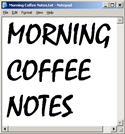
|
|||||||||||||||||||||||||||||||||||||||||||||||||||||||
XML Magazine: Bootstrapping. "I chose Python deliberately, knowing that it would not be familiar to most readers of this column. Truthfully, I had not programmed in Python myself before writing the column." As you may recall, a couple of weeks ago I wished we could add the Washington Post, Wall Street Journal and New York Times to the roster news sources syndicating in RSS. The next day a friend sent a pointer to a public Web server where XML versions of the Times feeds were being updated. Their format, while transparently simple, required conversion before it could plug into RSS-based aggregators. On this page I describe the conversion, and point to a folder on a UserLand-run server where the RSS versions of the feeds are updated hourly. There's much more to say. They're pushing links to articles, following the grain of the Web; not pushing story content. This builds flow for their site, and allows them to add interactive features at the single canonical location for the story. It's a win for news readers and software developers, because with the Times flow in the mix, we have news that covers the world and technology, the Times book and movie reviews, art and education news, sports and editorial pages. This is by far the broadest availability of syndicated content for a major newspaper. So the Times is again a leader, not just in print, and on the Web, but also in the newest XML-based syndication technologies. Of course this raises the question "Is this appropriate?" and I've debated this with myself and others over and over. I've attempted to contact the Times, to let them know what we are doing. While they have not given their approval, or responded in any way, the XML files are updating and remain accessible. We are not disclosing their location or format. I see this as a potential flow-builder for the Times, and a big boost for the developing medium. While I hope the Times keeps these resources accessible, of course it's their choice. Interesting. AirWave is a wireless ISP in the Bay Area. Also interesting. Dan'l Lewin signed on at MS as busdev veep for dot-net. He's got a rep as a good guy in hard jobs. Well-known in the Valley. I was interviewed today about RSS, and the reporter asked "Well, my readers are IT People, why should they be interested in software from a small company?" I responded with a question of my own. "When do large companies create truly new things?" BusinessWeek: Crossgain vs Microsoft. It's official, I can no longer even maintain a semblance of keeping up with email. Overload to the nth degree. Spent the day yesterday at Microsoft. 830 emails waiting. As usual Microsoft impresses. I will not be able to report on the meeting, unfortunately, although I would like to.  In the meantime, read these articles about Microsoft's CLR, and think and read between the lines. I hadn't understood how pervasive the CLR was going to be. My surprise is not based on anything new, MS has been talking about the CLR since last summer, I just wasn't fully tuning in. The thing to watch for is Microsoft's version of the Web. Now that they basically control the Web browser (deprecate the word "basically") this becomes more of an issue. I like HTTP. I like XML. I like SOAP. It's like a stack. (It is a stack.) It's open, and therefore subject to innovation. I am not a Microsoft developer and never will be. That shouldn't be a problem for Microsoft. But, I think it is, for some at Microsoft, perhaps. Davos: "No one shared Joy’s pessimism.." Tim O'Reilly was at the Microsoft meeting. We talked quite a bit. I found out more about their XML-RPC book, which apparently will be out soon. It's good to know that Clint Laskowski is not angry. MacHTTP is back.
|
|
||||||||||||||||||||||||||||||||||||||||||||||||||||||
|
© Copyright 1997-2005 Dave Winer. The picture at the top of the page may change from time to time. Previous graphics are archived. Previous/Next |
|||||||||||||||||||||||||||||||||||||||||||||||||||||||
